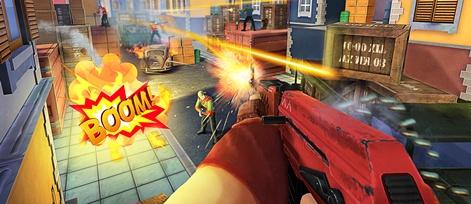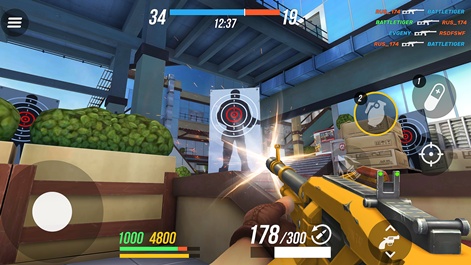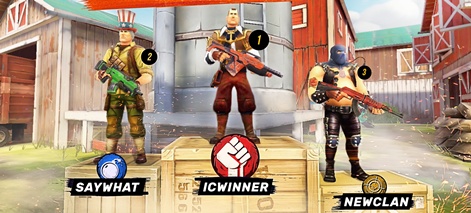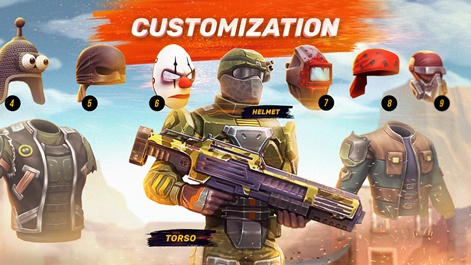Game Insight's first-person mobile shooter Guns of Boom exploded onto the app stores in May 2017.
It's made a quick start to life, shooting past five million downloads in two weeks, and by two months it had already racked up over 10 million.
It's already proving a success, but it appears there's a lot more to come from the game with ambitions to develop its eSports potential.
We caught up with Game Insight CEO Anatoly Ropotov to find out more about the hit title, how it has made FPS fun on mobile and what its plans are for the future.
PocketGamer.biz: Game Insight hasn't traditionally been known as an FPS developer. What inspired Guns of Boom, and when did you begin working on it?
Anatoly Ropotov: It’s probably a cliché to say that the best games come from folks that are making games for themselves, but that’s really the truth. I was a competitive Quake player, and have spent countless hours addicted to Team Fortress 2.
We're all fans of the genre here, whether that’s the good old days playing Counter-Strike, Halo, or Modern Warfare, to more recent experiences like team terrorist hunts on Rainbow Six Vegas, or our latest inspiration, Overwatch.
We wanted to create a game that we could play together in our offices – to take a break from making games and just shoot some faces.
As it turned out, there was a huge demand since no one had been able to fit all the pieces together right on mobile. We wanted to fill that void with the best FPS on mobile, and you can download and play the result of that right now.
Where do you feel mobile shooters have historically failed and how did you aim to address these issues with Guns of Boom?
When we set out to make Guns of Boom there were other mobile shooters out there, but often they didn’t take into account important platform features and characteristics, or the controls were too complex and overloaded.
Some of these games dropped players into maps that were way too big and unwieldy for short mobile sessions. Others just couldn’t get the dynamics and pacing of the gameplay right – either too fast and hardcore, or too slow and, well, boring.
That’s not even getting into the technical issues such as poor optimisation, problems with netcode and even the size of the apps.
Development of the best control scheme wasn’t easy, but it ultimately laid the foundation for the core gameplay that struck a chord with players.Anatoly Ropotov
At its core, the problems boiled down to developers trying to rush the PC and console experience onto mobile while missing the most important point – organically adapting that experience so it actually feels natural on mobile devices.
In addition to sidestepping those pitfalls, we took a cue from the breakthrough that Halo made at a time when FPS offerings on living room consoles still left players… skeptical.
The approach was to start from the player’s experience, make them forget about the strangely shaped chunk of plastic in their hands (or in our case, the glass touchscreen of their device), and let them precisely guide their character and connect directly to the action.
It turned out to be the perfect solution, providing a seamless and genuine experience for FPS fans on mobile.
How important was it for you to find a control scheme that worked for touchscreen shooting and how did you arrive at what we see today?
Development of the best control scheme wasn’t easy, but it ultimately laid the foundation for the core gameplay that struck a chord with players. It all started with finding that nugget of gameplay gold.
Luckily, we started with a very simple control model that didn't have the extra mechanics like jumping, crouching, peeking or parkour cover mechanics that you see in modern PC/console shooters.

This has the added benefit of keeping the UI to a minimum, which means you have more of the screen to see what you’re shooting.
We found some success when we tried adding aim assist and auto-fire during development. Lining up a really clean shot at your opponent proved to be the main satisfaction point.
Also, spotting and training the right shot is really the primary skill that we wanted players to engage in, rather than tapping the target at the right time. Though you can still do a number on an enemy by getting up close and tapping that melee attack button.
All said, a tonne of time went into polishing that core mechanic so it would feel as natural as possible on a touchscreen. We spent a bunch of time in internal testing, as well as company-wide sessions where we'd announce a tournament and everyone would stop what they were doing to play.
Collecting all the feedback from those tests really helped the designers dial in the controls and get the game out of the player’s way before we even went to beta. The end result is what you’re seeing today.
How big was the team on Guns of Boom and how long was the total development time?
That makes it sound like we’re done with it! We’re still very actively developing new modes and features, and we have quite a large team working on the game. You might say Guns of Boom had an unorthodox development process though, since it started with a PC version.
You might say Guns of Boom had an unorthodox development process though, since it started with a PC version.Anatoly Ropotov
We believe that played a huge role in the game’s success, since we polished the hell out the game on PC first. And by that I mean hundreds of internal play tests and tournaments across all of our offices. That’s a lot of players and playtime.
Once it started to feel and play great, we transferred what we’d achieved to mobile platforms.
After many iterations, qualitative reworks and sleepless nights over two years of development, Guns of Boom became what we see now - and nothing speaks to its success better than the feedback we’re getting from our players.
What inspired the game's bright and colourful aesthetic? Was it always your intention to avoid the grim and militaristic look?
Inspired by Team Fortress and Overwatch, we wanted to create a game that both hardcore and casual players would enjoy, so we settled on a perfect blend of a cartoonish and light-hearted setting balanced with a militaristic style.
Another reason behind our choice was graphics optimisation. It plays a huge role when you are creating a game for a wide range of mobile devices so that all of our players - not only the owners of top devices - could enjoy the game.

Also, by taking a step away from realism in the game’s look, players are not expecting realistic weapon behaviour. This allows us more leeway to be creative and bold in our ideas. The result is an added degree of explosive fun and dynamism to the fights.
What did you learn from the soft launch period and what were the biggest changes you enacted as a result?
At the beginning of the beta, we really focused on that core gameplay. That’s what we were testing for quite some time, and as soon as we saw players were coming back regularly and talking about the game, we were confident about switching focus to the meta layer of gameplay.
We actually changed how players get and upgrade their guns and equipment radically several times during this period.
Optimising for such a wide range of smartphones - not just Android flagships and iPhones - was a feat in and of itself.Anatoly Ropotov
Asides from the controls, we were able to optimise and improve the game’s stability for a wide variety of devices. Working on gameplay features and carefully listening to our players feedback allowed us to build a strong foundation to confidently set our course for development after release.
How technically difficult is it to give eight players a real-time PvP experience on a single map on mobile?
Iit was tremendously difficult for one simple reason: while players’ expectations for online shooters are set high from the crisp experience on other PC and console, you can’t count on the hardware or the connectivity to be rock solid on mobile. We really had no room or intention to compromise on the technical side of things.
For our servers, years of work went into making a robust server that could handle and compensate for high-latency situations. And, very importantly, we designed them to avoid those situations whenever possible by putting the right players together during matchmaking.
On the client, optimising for such a wide range of smartphones - not just Android flagships and iPhones - was a feat in and of itself and deserves an article of its own.
Also, the gameplay was designed in such a way that it would be more robust when latency could otherwise become an issue. After tuning the pace of the game, the movement of the characters turned out to be relatively slow. Plus it takes quite a bit more fire to bring down an enemy as compared to other shooters.
Those points, combined with a host of other finely tuned micro-features, yielded an excellent experience even over a weak internet connection. In fact, even if a player experiences lag we can accurately calculate their fire and predict the outcome to make sure everything plays out as smoothly as possible because we follow the match on our server.

In other words, you can expect the game to play perfectly on 3G, which is crucial for a game that’s literally designed to be played on the go.
What was the biggest challenge you faced during the game's development?
The biggest challenge we tackled resulted in one of the best features of the game: tuning the controls. As I mentioned earlier, we’ve not seen any easy-to-play PVP shooters on mobile and this is what really makes Guns of Boom stand out
It was a long road with all our internal play testing and dozens of discarded options until we finally found that magic recipe of auto-fire, aim assist and all the other micro-features that made the controls really intuitive and accessible.
The result is a game with controls that are easy to master – even for a player who has no experience with first-person shooters.
The reaction from players has exceeded all of our expectations. The feedback we’ve received has blown us away.Anatoly Ropotov
That being said, it’s not like we feel “we’ve arrived” and we’re done making improvements, either. In our latest update, for example, we added weapon switching and reloading just by double tapping anywhere on the screen. This micro-feature alone adds a new level of speed and skill to play.
How do you reflect on the game's launch? Are you happy with the reception thus far?
The reaction from players has exceeded all of our expectations. The feedback we’ve received, not only in written form but also in numbers, has blown us away.
In just two months since the worldwide launch, Guns of Boom has more than 10 million players and continues to grow. We’ve seen more than 100,000 videos uploaded on YouTube and high ratings in all the stores. This is the best motivation that a developer can possibly receive and our team keeps working harder each day.
Players are our everything and we want to treat them accordingly.
What's next for Guns of Boom?
We see Guns of Boom as a strong eSports title and we are working on new features that reflect this, allowing you to play with friends and your clan in a totally new way.
Right now we are building a whole new environment around the game with all the necessary elements of a competitive first-person shooter, ready to rock the eSports stage. What’s more, players can expect unique and never-before-seen features both on mobile and the FPS genre at large.
Active development in all directions never stops. We are always listening to our players and improving all the existing parts of the game, such as weapons and equipment, in order to keep everything well-balanced.

Secondly, to satisfy even the most demanding players, lots of new stuff is being developed: new maps in unexpected settings, impressive new weapons and tons of customisations like masks, and full body and weapon skins.
We are even experimenting with several new team-based gameplay modes. You’ll hear more about that soon.
We’ve seen tons of player-submitted videos and we want to give back by making all those great videos accessible directly from inside the game in a new version of the VideoHub. It’s a great opportunity for all of the creators in our community.
There’s much more happening right now, and we can’t wait to share it with everyone. I recommend following us on Facebook and joining the live discussion with devs in our Discord chats.




















